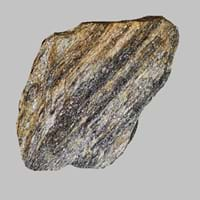Suevite and Mylonite
Definition
Definition
During the impact melted material forming a breccia containing glass and crystal or lithic fragments together form Suevite rock.
Mylonite is a metamorphic rock formed by ductile deformation during intense shearing encountered during folding and faulting, a process termed cataclastic or dynamic metamorphism
History
Origin
Canada, Germany
New Zealand
Discoverer
Unknown
Unknown
Etymology
No etymologies found
From Greek mulōn mill + -ite
Class
Metamorphic Rocks
Metamorphic Rocks
Sub-Class
Durable Rock, Medium Hardness Rock
Durable Rock, Medium Hardness Rock
Family
Group
Not Applicable
Not Applicable
Other Categories
Coarse Grained Rock, Opaque Rock
Fine Grained Rock, Opaque Rock
Texture
Texture
Earthy
Foliated
Color
Black, Brown, Colourless, Green, Grey, Pink
Black to Grey
Maintenance
Less
Less
Durability
Durable
Durable
Water Resistant
Yes
Yes
Scratch Resistant
Yes
Yes
Stain Resistant
No
No
Wind Resistant
No
No
Acid Resistant
No
No
Appearance
Banded
Dull, Banded and Foilated
Uses
Architecture
Interior Uses
Decorative Aggregates, Homes, Interior Decoration
Decorative Aggregates, Interior Decoration
Exterior Uses
As Building Stone, As Facing Stone, Garden Decoration, Office Buildings
As Building Stone, As Facing Stone, Paving Stone, Garden Decoration
Other Architectural Uses
Curbing
Curbing
Industry
Construction Industry
As Dimension Stone, Cement Manufacture, for Road Aggregate, Making natural cement, Manufacture of Magnesium and Dolomite Refractories
for Road Aggregate, Landscaping, Roadstone
Medical Industry
Not Applicable
Not Yet Used
Antiquity Uses
Artifacts, Monuments, Sculpture
Artifacts, Monuments
Other Uses
Commercial Uses
As a Feed Additive for Livestock, Gemstone, Metallurgical Flux, Source of Magnesia (MgO)
Creating Artwork, Gemstone, Jewelry
Types
Types
Phyllosilicates, Calcite
Blastomylonites, Ultramylonites and Phyllonites
Features
Host Rock for Lead
Surfaces are often shiny
Archaeological Significance
Monuments
Used
Used
Famous Monuments
Data Not Available
Data Not Available
Sculpture
Used
Used
Famous Sculptures
Data Not Available
Data Not Available
Pictographs
Used
Used
Petroglyphs
Used
Used
Figurines
Used
Used
Fossils
Absent
Absent
Formation
Formation
Suevite is a metamorphic rock consisting partly of melted material, typically forming a breccia containing glass and crystal or lithic fragments, formed during an impact event.
Mylonites are ductilely deformed rocks formed by the accumulation of large shear strain, in ductile fault zones.
Composition
Mineral Content
Coesite, Quartz, Stishovite
Porphyroblasts
Compound Content
CaO, Carbon Dioxide, MgO
Aluminium Oxide, Calcium Sulfate, Chromium(III) Oxide, Iron(III) Oxide, Magnesium Carbonate, Silicon Dioxide
Transformation
Metamorphism
Yes
No
Types of Metamorphism
Burial Metamorphism, Cataclastic Metamorphism, Contact Metamorphism, Hydrothermal Metamorphism, Impact Metamorphism, Regional Metamorphism
Not Applicable
Weathering
No
Yes
Types of Weathering
Not Applicable
Biological Weathering, Chemical Weathering, Mechanical Weathering
Erosion
No
Yes
Types of Erosion
Not Applicable
Chemical Erosion, Sea Erosion, Wind Erosion
Properties
Physical Properties
Hardness
5.5
3-4
Grain Size
Coarse Grained
Fine Grained
Fracture
Uneven
Conchoidal
Streak
Light to dark brown
White
Porosity
Less Porous
Highly Porous
Luster
Earthy
Shiny
Compressive Strength
Not Available
1.28 N/mm2
32
Cleavage
Irregular
Conchoidal
Toughness
Not Available
Not Available
Specific Gravity
2.86
2.97-3.05
Transparency
Opaque
Opaque
Density
2.8-2.9 g/cm3
2.6-4.8 g/cm3
Thermal Properties
Specific Heat Capacity
0.92 kJ/Kg K
10
1.50 kJ/Kg K
3
Resistance
Heat Resistant
Heat Resistant, Impact Resistant, Pressure Resistant
Reserves
Deposits in Eastern Continents
Asia
Not Yet Found
China, India, Indonesia, Saudi Arabia, South Korea
Africa
Not Yet Found
Eritrea, Ethiopia, Ghana, South Africa, Western Africa
Europe
England, France, Germany, Great Britain, Netherlands, Sweden, Switzerland, United Kingdom
England, Finland, France, Germany, Great Britain, Greece, United Kingdom
Others
Not Yet Found
Not Yet Found
Deposits in Western Continents
North America
Not Yet Found
USA
South America
Not Yet Found
Not Yet Found
Deposits in Oceania Continent
Australia
Not Yet Found
Central Australia, Western Australia
All about Suevite and Mylonite Properties
Know all about Suevite and Mylonite properties here. All properties of rocks are important as they define the type of rock and its application. Suevite and Mylonite belong to Metamorphic Rocks.Texture of Suevite is Earthy whereas that of Mylonite is Foliated. Suevite appears Banded and Mylonite appears Dull, Banded and Foilated. The luster of Suevite is earthy while that of Mylonite is shiny. Suevite is available in black, brown, colourless, green, grey, pink colors whereas Mylonite is available in black to grey colors. The commercial uses of Suevite are as a feed additive for livestock, gemstone, metallurgical flux, source of magnesia (mgo) and that of Mylonite are creating artwork, gemstone, jewelry.
|
||
|
||
|










